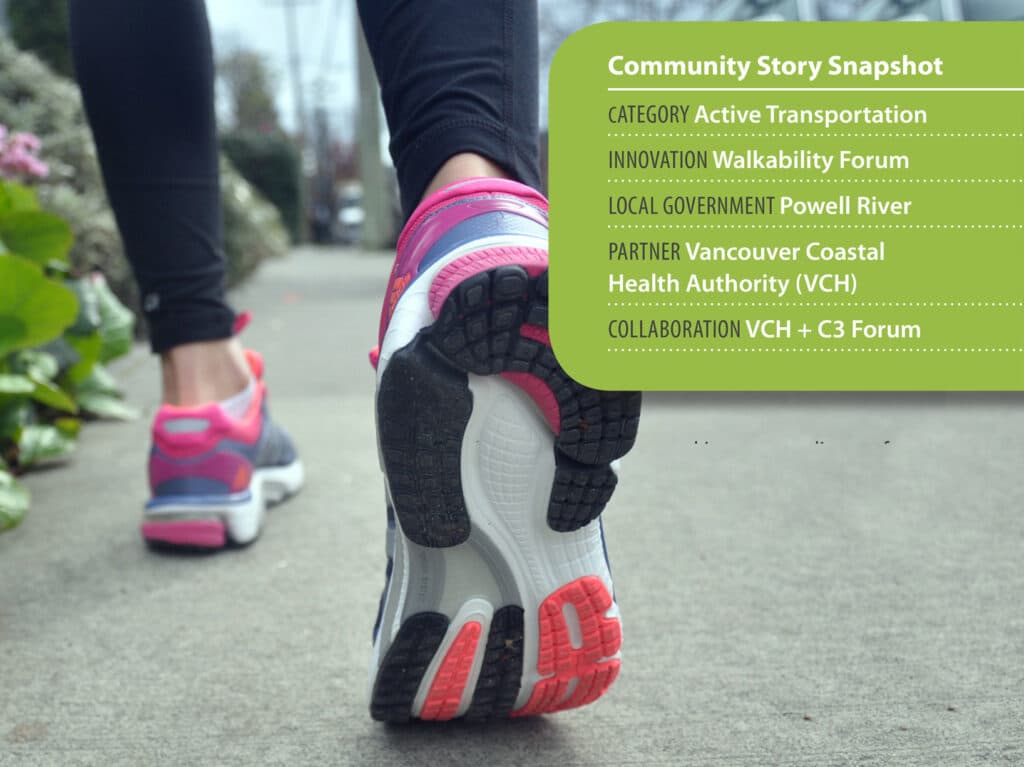Powell River’s two-day Walkability Forum helped community members see the linkages between health and the built environment. The Forum is an example of local governments and a health authority working together on implementing a common priority – active transportation.
Overview
Chronic disease prevention isn’t always about personal choice. That’s one of the messages shared with residents at the Powell River Walkability Forum. Attendees of the Forum learned that 60% of population health outcomes are attributed to the places we live and social and economic determinants.
“Our tendency is to say you’ve got to do your 150 minutes of exercise each week or eat your 6-8 servings of fruits and vegetables to be healthy and we forget to consider the context of their lives. Is this choice possible for everyone?” said Claire Gram, a policy Consultant and Healthy Built Environment Lead from the Vancouver Coastal Health Authority (VCH). “We need to look at the environmental factors as well as individual and make the healthy choice the easy choice.”

The forum was organized by a partnership of VCH and three Powell River local governments. Together they planned a general public conference, a stakeholder meeting, and a discussion with the Tla’amin Nation to make up the overall Forum. These events encouraged open discussion regarding the current situation in Powell River.
Learning from the Process
Although Powell River is located in a mild climate on the beautiful upper Sunshine Coast and is interlaced with many accessible walkways, their community members are considerably auto-dependent. Promoting and improving walkability is a priority for local governments in order to improve community physical activity.

“Healthy neighbourhood design and healthy transportation networks can play a significant role in encouraging community members to make healthier choices and decrease the risk of chronic illness,” explained Gram, one of several presenters at the forum. She emphasized several linkages between planning principles and health outcomes.
The healthy planning linkages were echoed by Chris Morwood, the Vice President and Active Transportation Lead of the Powell River Cycling Association (PRCA). “Well-designed, inclusive streets can create economic, carbon, social and health benefits for a community, ” said Morwood.
Other presenters shared further linkages such as the business case for improving walkability. “Trails add tremendous economic value to communities in that they make places more attractive to live. Generally, housing prices increase the closer they are to trail systems and they are often the most sought after amenity by people considering relocation decisions,” explained Nicole Vaugeois, BC Regional Innovation Chair in Tourism and Sustainable Rural Development at Vancouver Island University. A walkability strategy in Whistler was described by Val Litwin, the CEO of the Whistler Chamber of Commerce.
A World Café method was used to explore what improvements could be made in the area of active transportation. Valuable feedback was gathered over the two days. For example, members of the Tla’amin Nation walking clubs shared safety concerns such as unleashed dogs and wild animals. Members of the PRCA described streets as the largest public spaces in a city when discussing their work improving connections between existing trail and road networks both in the city and regional district. “Streets should be designed to accommodate both active and motorized traffic of all ages.” said Chris Morwood.
“It’s about building the relationships to make the interactions smooth.” Claire Gram, VCH
The discussion provided the partners that organized the event with significant insight to assess what the community wants and needs to improve walkability. The group discussed what infrastructure was existing which helped them put forward suggestions on improving walkability. Ideas were gathered and compiled for city officials and regional stakeholders to review the following day.
Connections

VCH worked to build connections with members of the C3 forum and other regional stakeholders. They invited residents and regional stakeholders to participate in a Powell River Walkability Forum. PRCA helped plan and implement the forum and their strong connections with community stakeholders were key factors that contributed to the success of the event.
Innovative Outcomes and Impacts
What made the partnership between VCH and Powell River successful was finding common ground, combining efforts, sharing resources and developing a more meaningful relationship that engaged the community in their initiatives. In the past VCH helped communities within the jurisdiction on high-level planning such as reviewing Official Community Plans. The Walkability Forum was the first collaborative effort between the different entities to implement activities on the ground. The Forum helped develop strong connections with community members and meaningful collaboration between organizers.
Click on the Prezi presentation below for an overview of the proces leading up to the forum and the outcomes.
The collaboration seems to be working as a number of great innovations in active transportation have been initiated in Powell River since the forum:
- City Cycling Infrastructure plan with commitment to $200,000 gas tax
- Stakeholder and Advisory meetings on active transportation
- A three-part series published in Powell River Living magazine August – October 2014
Resources
Learn more about how community health intersects with the built environment:
- Healthy Built Environments (PlanH)
- Healthy Families BC Communities
- Healthy Canada by Design CLASP (Heart and Stroke Foundation)
- Provincial Health Services Authority: Linkages toolkit
- BC Climate Action Toolkit: www.toolkit.bc.ca
- Video: Claire Gram on the connection between community design and health





